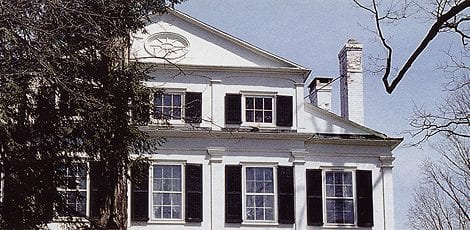
Discovering the Past: The Detective Work of a History Intern
Working on the Hasbrouck’s of Locust Lawn exhibit this semester has been both challenging and rewarding in a multitude of ways. While the work itself has been extremely time consuming, I feel as if I have learned so much this semester in terms of what the day to day work of a historian can actually look like. For the most part, I’ve spent a lot of time transcribing different documents and letters. It has been really exciting to complete a transcription or to finally figure out what a key word is. I also wasn’t expecting to be able to pick up on different people’s handwriting so quickly. In one instance, I was transcribing an essay written by Sarah Maria, one of the daughters at Locust Lawn, in which she was comparing the life in the city with life in the country. The first page or two took a very long time to read, but I quickly began to recognize the specific ways she would shape letters, or how sometimes her ‘h’ or ‘k’ would look similar but did, in fact, have a slight difference. After realizing little things like that, the documents become an even greater connection between you and their author. In turn, the author slowly transforms from an ambiguous figure of the past into a living entity.
I’ve also found that being a historian is a lot like being a detective. There was one instance in which we were looking at a group of letters from when the Hasbrouck daughters were attending the New Paltz Academy. On one letter, the date did not coincide with the timeline that we had established. After a long time of looking over this document and trying to understand the date, I noticed a faint line across the page that ran over part of the date. After noticing this, I asked my supervisor, Susan Stessin-Cohn, if it was possible that the corner of the page was ripped before this letter was copied. We soon realized that what we thought was a zero was actually a six or an eight. This discovery came with great relief and excitement and was the first time I realized how investigative history can be, beyond just the research.
Another example of this that I experienced over the semester was in my research of what appeared to be an old music box. Earlier in the semester, Susan had given me a book filled with pictures of objects that were in the house at Locust Lawn. After transcribing the will of Hylah Bevier Hasbrouck, I was looking through these pictures to see if I could match anything from the will. This was when a photo of an old paper roll organette caught my eye. Off of a whim I decided to do some research on it and see what I could find. I began with only the picture and a magnifying glass. I managed to read the makers mark off of the lid of the organette, which read “Mechanical Organette Co New York”. The other lettering on the lid read “Celestina”, which turned out to be the type of organette. By doing some research on this company and the Celestina I learned that this was a high quality twenty note organ that was played by turning a hand crank. A vacuum was created inside the organette and the air would travel through holes on a paper roll that would travel over a track bar. I also learned that the organette began to lose popularity in 1900 when the home phonograph became more common. My next goal was to try and find records of this object in any of the documents that I had. There was no mention of it in Hylah’s will or in a few other inventories that I looked at. Finally, I found a document titled “Report given by Annette Young”. Annette Young was the last person to own Locust Lawn before it was sold and turned into a museum. In this document it said, “The Celestina which was used in the New Hurley Church, goes back to the period of about 1870. It was used by a Mr. Hendricks, who gave it to Mr. Byron Terwilliger. The one who outlived the other would keep it. Mr. Terwilliger lived to be 91. He gave it to this house and Miss Annette Young.” I know not only have a date for the organette but also the story of how it ended up at Locust Lawn. This was a very rewarding moment because I had essentially gone from only have a picture, to having the backstory and history of an object in the house. This, once again, brought the history of this place to life. When you spend this must time looking at the personal belongings of a group of people, they begin to become very real individuals to you. I no longer feel like I’m just researching an object or event from the past, but rather I’m looking into the lives of a very real and dynamic family, who just so happened to live in the Hudson Valley in the mid-19th century.